Pick of the Patch
An innovative Whanganui couple adds a third protein to their farming operation alongside the production of beef and lamb. Bringing pumpkin seeds, pumpkin oil and pumpkin flour to the market is a labour of love. Words Kate Coughlan. Photos Alanah Brown.
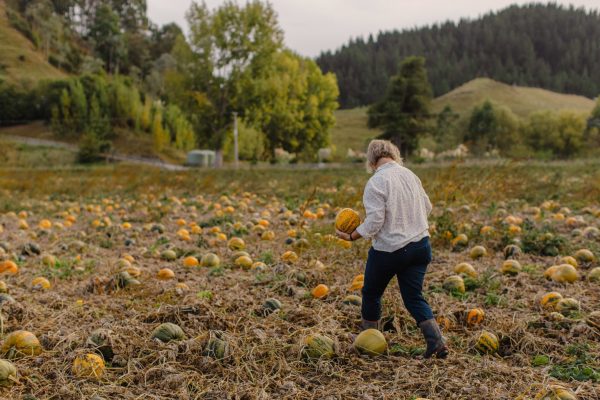
Within days of the Adkins family planting their first crop of seed pumpkins in December 2022, the heavens broke open and stayed open. The initial deluge was followed by days of persistent rain. All eight hectares sown in Austrian hulless pumpkin seeds remained stubbornly brown. Clare and Grant watched anxiously for signs of germination. Eventually, they accepted the reality that their pumpkin seeds had drowned. They took a deep breath and decided to resow.
When green shoots emerged weeks after the second sowing, they were greatly relieved and observed their babies growing nicely in rows on their flats. They tended them with care, painstakingly hoeing by hand around the young plants to remove weeds to stay true to their spray-free philosophy. This was followed by an application of seaweed fertiliser to boost the plants’ immune systems against growth-slowing powdery mildew. Soon the plants were holding hands across the aisle and bursting forth in the typical exuberance of a happy pumpkin patch. When the plants began to flower, Clare and Grant’s excitement grew and their thoughts turned to what was ahead in this new farming operation.
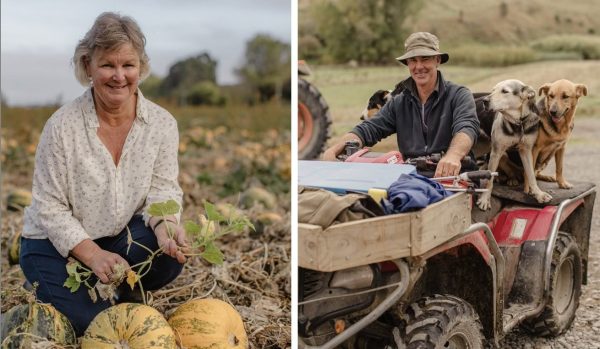
For several years prior, they had admired and closely watched the pioneering efforts of a former neighbour who introduced the Austrian hulless pumpkin seed crop to his family farm in the Marton district. Hulless pumpkins are not grown for their flesh but to be harvested for their seeds; for human consumption, or to be processed into oil and flour. When the opportunity arose for Grant and Clare to buy the pumpkin seed business, they took it, keen to add another protein harvest to their existing beef and sheep farming operation.
They converted one of the farm’s three-bay sheds to the requirements of the pumpkin operation by concreting the floor, installing a 100-plus-year-old Andrews & Beaven seed grader, a seed-washing machine, a gas-fired drying system, and creating packing areas.
With a client list and harvester, known unaffectionately as ‘The Beast’, they were ready to fit the requirements of this new pumpkin crop into an already busy farming schedule of lambing, calving, weaning, tailing, drafting and shearing.
The wet spring of 2022 turned into a better early summer as January 2023 dawned. The crop was coming along nicely with plants covered in pumpkin buds. It was a joy to behold, and everything seemed aligned for a good inaugural harvest.
Hulless pumpkins are not grown for their flesh but to be harvested for their seeds; for human consumption, or to be processed into oil and flour.
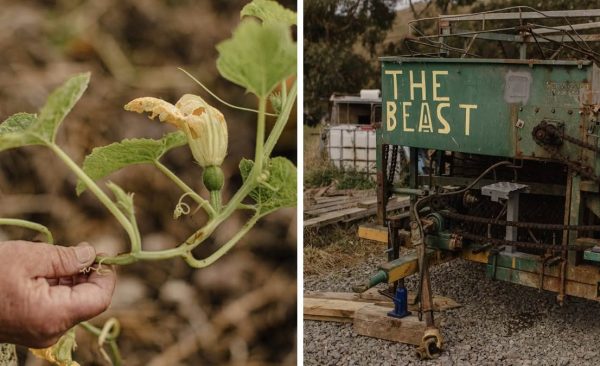
Then the heavens opened again, this time for what became known as the Anniversary Day storm, followed days later by Cyclone Gabrielle. Though Whanganui was not in the direct path of either tropical depression, significant rain came on the back of an already wet season – officially New Zealand’s worst summer recorded. It filled creeks to overflowing and an unstoppable river of water headed straight across the pumpkin paddock. It didn’t ruin the entire eight-hectare crop, but it did drown five and a half hectares of it.
‘That’s farming,’ say Clare and Grant. ‘From the moment we put the seed in the ground, that first crop was a hell of a learning curve.’ Fortunately, they had the stoicism necessary for successfully pioneering new crops in New Zealand’s challenging climate.
‘With our second harvest, of autumn 2024, the pendulum had swung quite the other way and we had an amazingly successful crop,’ says Clare. ‘The challenge was surviving the hard physical work required to get the crop out of the paddock, processed and ready to market. Grant admitted one day he’d rather be dagging lambs, and that’s the worst job in our farming calendar.’
The dry warm summer of 2023–2024 saw 10 hectares of pumpkins ready to go under The Beast for harvest and each day, from the beginning of April until the end of May, the machine was towed across the pumpkin patch with its spiked roller feeding pumpkins into churning augers. These augers fill 100 kg bins with sloshy wet seeds to be taken for washing, drying and grading. The shell and the flesh stay in the paddock and this is no loss as the flesh of Austrian hulless pumpkins is inedible to humans, though cows like it and it breaks down quickly into the soil.
With hindsight, Clare wonders if they were lucky their first crop was rather a washout. That small harvest gave them a chance to understand what was involved and learn the vagaries of the equipment such as The Beast and the seed grader. ‘That seed grader is the second thing Noah built, I reckon. At the turn of the previous century, this very machine was used in Foxton to grade flax seeds. It is modified for pumpkins and it’s poetry in motion when it gets going.’
Clare wonders how husband Grant kept all the balls in the air and is eternally grateful for the help they received; their daughter Annabelle came home for several months to help them through harvest, a neighbour did a month of tractor work, and a team of Fijian scrub cutters broke the back of the hand-hoeing.
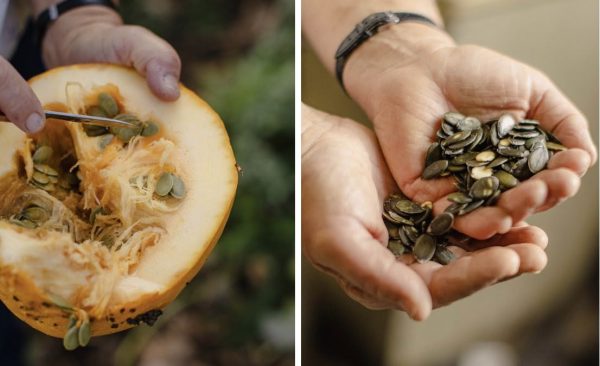
But why pumpkin seeds?
‘In Austria, where this particular seed originates, pumpkin seed oil is regarded and used in the same way as we use olive oil. It has characteristics of terroir and is judged with the same degree of competitiveness as olive oil is in other countries,’ says Clare. ‘It is a special pumpkin variety and when the flesh is broken open the seeds are ready to be eaten, whereas the imported seeds have to be put through a mechanical or chemical process to release the seed
from its hull.
‘Our pumpkin seed oil has a low smoke point so is best used in dressings, over stir-fried vegetables or as a dip for bread. It has a lovely deep red colour. The flour, which is 52 per cent protein and gluten-free can be used as a wheat flour substitute at a ratio of about one-third pumpkin seed flour to two-thirds wheat or a gluten-free flour. We use it in more rustic baking items such as scones, carrot cakes, muffins and chocolate zucchini cakes. And the seeds are delicious eaten straight out of the packet or roasted in tamari or soy.’
It is a special pumpkin variety and when the flesh is broken open the seeds are ready to be eaten.
As the hard work of harvest came to an end, Clare and Grant took stock. It had been a busy time, but they were overjoyed at the size of the harvest and the lovely taste and texture of the seeds and oil.
‘Gone are my gardening days, and even housework,’ laughs Clare. ‘At the end of the harvest, as we took stock, I felt about 100 years old yet with such positivity about the future. We love what we are doing. It is our baby and we want to be hands-on at this stage so we know every part of the process and every aspect of the business.
A local couple, young beekeepers, put hives in the Adkins’ pumpkin paddocks to see what pumpkin honey is like and to ensure good pollination for the pumpkins. ‘Pumpkin honey,’ reports Clare, ‘is lovely, mild and runny and just the perfect topping for a rustic bread partially made with protein-rich pumpkin flour.
With their vigilant focus on sustainable protein production, the 2025 year will include experimentation with cover crops between pumpkin rows to reduce carbon exposure from bare soil, reduce moisture loss and deter weeds. Thanks to the wandering nature of pumpkin vines, mechanised tilling to control weeds is out of the question so a cover crop is hoped to reduce the hand-hoeing hours.
‘Grant and I are proud to be producing another healthy protein for New Zealanders, and one that tastes great,’ Clare concludes. ‘I’m sitting in the sun and finishing a pumpkin honey sandwich before getting on with sending out the online orders!’
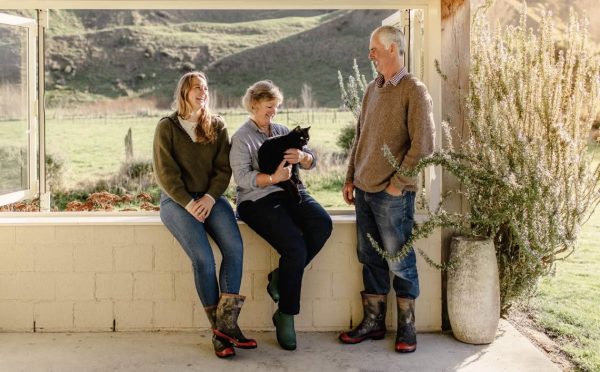
At a Glance – The Adkins’ farming operation
404 hectares inland from Whanganui, two-thirds in steep hill country
150 cattle
2,000 ewes
10 hectares of pumpkins sown
6 tonnes of dressed seed in 2024

Summer Hill Seeds: How it all Happens
Sowing – happens in December.
Hand-hoeing – as this is a spray-free operation, once the seedlings are visible competing weeds are deterred manually.
Feeding – with seaweed fertiliser increases immunity against powdery mildew that can slow growth.
Stand back – once the plants get going ‘holding their hands across the aisle’ as Clare describes it, there’s no more cultivation possible.
Harvesting – with The Beast towed behind the tractor, begins in April and ends in May.
Washing – the seeds are fed into a perforated drum.
Drying – is a gas-fired operation involving six 100 kg bins at one time, taking 11 hours.
Grading – the seed is separated into an A- and B-grade product.
A-grade seeds are packed for human consumption, and marketed directly online by Clare and retailed in organic/health food and bulk-bin stores.
B-grade seeds are sent to Marlborough to be processed for oil and the resulting roughage is milled into a 52 per cent protein flour.
C-grade seed, a by-product, is fed to the grateful cattle and any further waste product goes into the compost or is used as mulch around the vegetable garden.
Green credentials – The process from planting to customer delivery is spray-free. Seed and flour are sold in sturdy compostable paper bags or in cardboard boxes, oil is shipped in cardboard boxes packed in carded/combed wool, a by-product of carpet making. ‘Being sheep farmers receiving very low returns from their wool, I encourage customers not to use bubble wrap but to recycle the wool which can then be used in the garden as weed matting or be composted,’ says Clare.

